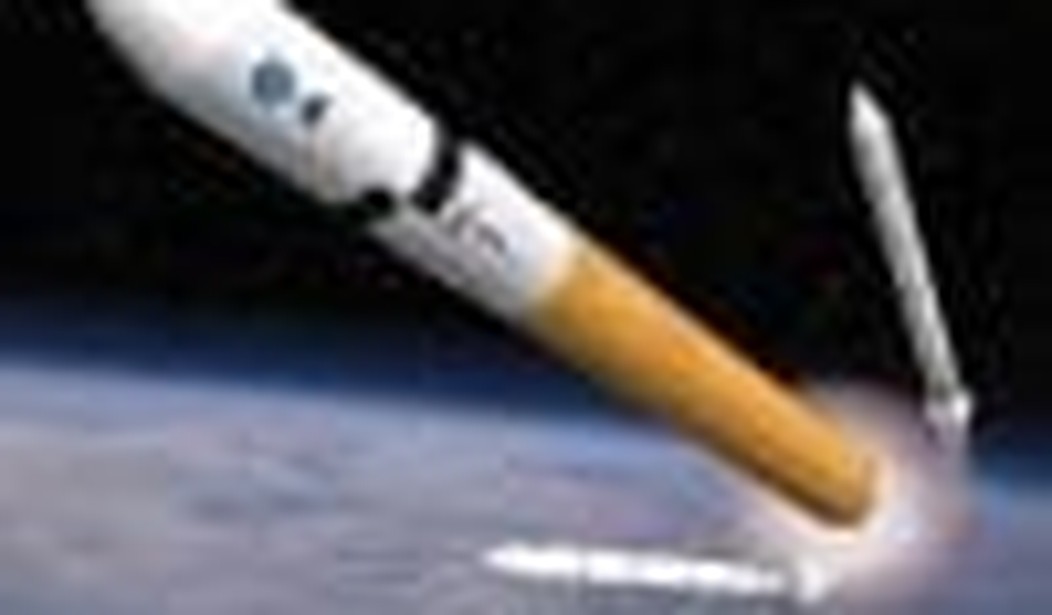The Spaceref web site has uncovered an internal NASA document that completely undermines the rationale for Shuttlyndra, or the Senate Launch System — Congress’s pork rocket to nowhere:
On 26 September 2011, Rep. Dana Rohrabacher (R-CA) issued a press release regarding fuel depots. This included a letter to former Administrator Mike Griffin who had dismissed the notion of fuel depots and commercial launch vehicles as being a viable alternative to the Space Launch System (SLS) during Congressional testimony.
Rohrabacher noted: “When NASA proposed on-orbit fuel depots in this Administration’s original plan for human space exploration, they said this game-changing technology could make the difference between exploring space and falling short. Then the depots dropped out of the conversation, and NASA has yet to provide any supporting documents explaining the change.”
Well, despite what NASA may or may not have been telling Rep. Rohrabacher about its internal evaluations regarding the merits of alternate architectures that did not use the SLS (and those that incorporated fuel depots), the agency had actually been rather busy studying those very topics.
And guess what: the conclusions that NASA arrived at during these studies are in direct contrast to what the agency had been telling Congress, the media, and anyone else who would listen.
For the uninitiated, propellant (not fuel — one needs an oxidizer as well) depots are storage facilities on orbit that allow the accumulation of the propellant needed for deep-space missions, which is most of the payload. When the depot has enough propellant delivered to support the mission, the propellant is transferred into the earth-departure stage, and the astronauts are sent on their way. Because the propellant can go up in arbitrarily sized quantities, it enables doing lunar missions, or asteroid visits, or even missions to Mars, without having to build a large Saturn-V-like rocket (most of the payload of the Saturn V for Apollo was mission propellant).
The internal NASA study shows that tens of billions of dollars can be saved with such a mission architecture, because that is how much it will cost to develop the new launch system that Congress insists that NASA build. In addition, missions can be mounted much earlier, because the money can instead be devoted to the actual mission hardware, launched on existing or soon-to-be existing commercial rockets. The NASA study team identified several alternate architectures to the heavy-lift baseline (which doesn’t do an actual lunar or asteroid mission until almost the end of the next decade), and all of them were faster and cheaper, and what NASA would be doing if its job were to actually explore space, as opposed to provide jobs in Alabama, Florida, and Utah.
This isn’t a new concept — it is similar to studies that I performed with Boeing seven years ago. And in fact, Boeing actually gave a presentation on such an architecture that also utilized propellant made from lunar ice at an aerospace meeting a couple of weeks ago. The Boeing briefing didn’t explicitly say that no heavy-lifter is needed (the company would no doubt still like to get a contract for such a vehicle if it moves forward), but it was easy to read between the lines, given that the architecture had no single piece larger than 12 tons — a tenth the size of the SLS.
But the big-rocket mafia has been ignoring them, because they are death to its space-pork agenda. They either pretend that such architectures don’t exist, or they denigrate them with spurious and specious technical arguments (too complex, we don’t know how to store or transfer propellant on orbit, it would take too many launches, there’s not enough launch capacity, etc.).
This NASA study, that just saw the light of day last week, no doubt to the regret of those at the agency who have been trying to keep it under wraps, blows up all those flawed objections. It shows how we could start sending humans beyond earth orbit early in the next decade using SpaceX Falcon Heavy vehicles, or United Launch Alliance Delta IV Heavies, or a combination of the two, while spending roughly half the money or less of NASA’s current plan. Beyond that, while the study doesn’t mention this, it would drive down the cost of launch for other users by creating a competitive market with a high flight rate. It would be an excellent market for testing new untried vehicles, particularly new reusable ones, because the payload is so cheap (propellant costs less per pound than milk, while satellites typically cost thousands of dollars per pound), and it doesn’t matter if one occasionally fails.
How long will the Shuttlyndra charade continue? If Congressman Rohrabacher was chairman of the House Space, Science and Technology Committee, it’s likely that he would have had hearings on it long ago and Shuttlyndra would have been exposed and perhaps on its way to the dustbin of history. Unfortunately, he’s not, because the current chairman, 88-year-old Ralph Hall of Texas and a supporter of Shuttlyndra, switched parties in 2004 in exchange for an offer from the Republicans to keep his seniority, and outranks Rohrabacher, so don’t expect hearings on this any time soon. But don’t expect it to go away, particularly in the coming fiscal maelstrom, as NASA is forced to choose between saving the Webb telescope and saving the congressional pork rocket. The former will allow us to see all the way to the beginning of the universe, while the latter is so short sighted, it can’t see beyond an election.









Join the conversation as a VIP Member